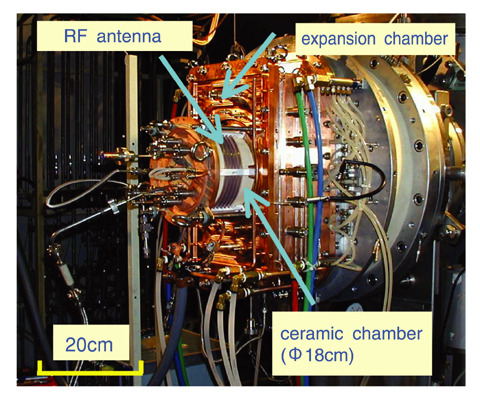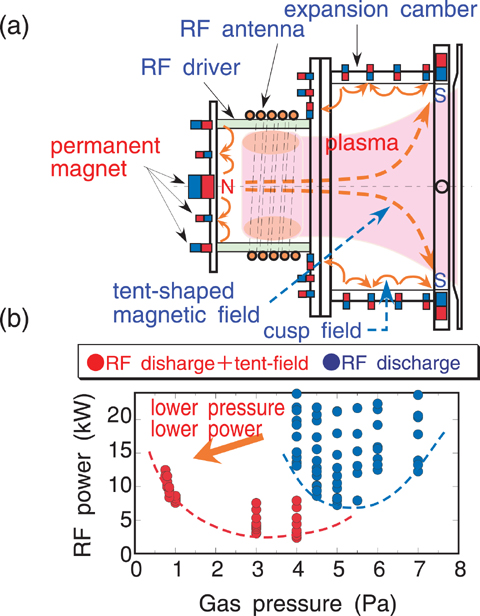
Fig.3-12 RF negative ion source

Fig.3-13 (a) Cross section of RF negative ion source and magnetic field lines, (b) operational region of RF negative ion source with and without the tent-shaped magnetic field
In "ITER" and "DEMO", neutral beam injectors (NBI) play an essential role for heating of the core plasma up to 100 million °C. In NBI, negative ions of hydrogen or deuterium are accelerated in a 1MV-class and are transformed into neutral beams. Such a high energy neutral beam must be stably in the core plasma for a long period. Therefore, the negative ion source must operate at high performance with high power, good uniformity and long lifetime. In NBIs installed in existing large fusion devices, the spatial profile of the negative ion beam is not uniform. This non-uniform beam causes local beam divergence, which results in high heat load on acceleration grids and beam line components. We have discovered that a magnetic field in the negative ion source induces the non-uniformity of negative ion beam. With a modified configuration with a tent-shaped magnetic field, we have achieved uniform negative ion beam extraction.
In conventional negative ion sources, negative ions are extracted from source plasma produced by heating filaments. The filaments often break during high power operation, which prevents a long-term operation of the negative ion source. Since the maintenance period is planned to be twice a year during "ITER" operation, the negative ion source must holdup under repetitive operation for six months.
For a maintenance-free ion source, we have started a development of an RF negative ion source (Fig.3-12) which does not use the filaments for plasma production. An electromagnetic wave is generated with an RF antenna, which ionizes a working gas, thus producing RF plasma. In case of hydrogen gas, plasmas produced with the RF waves of 2MHz could not be sustained under the 4 Pa in the ion source. However, the negative ion source for "ITER" is required to operate at 0.3 Pa to reduce the stripping loss of accelerated negative ions by collisions with residual gases.
Here we have applied a tent-shaped field combined with a cusp field formed by permanent magnets (Fig.3-13). As a result, plasma loss on the wall was suppressed, enabling RF plasma production even when gas pressure is under 1 Pa and with lower RF power. This method is effective for the low pressure operation of a RF negative ion source needed for the ITER NBI.